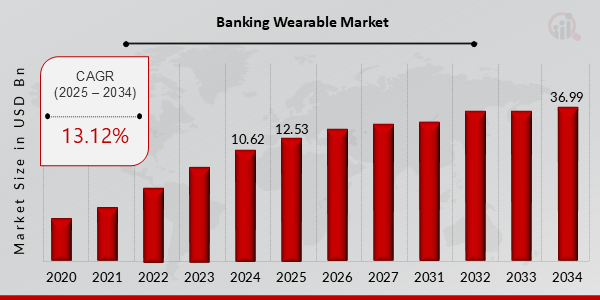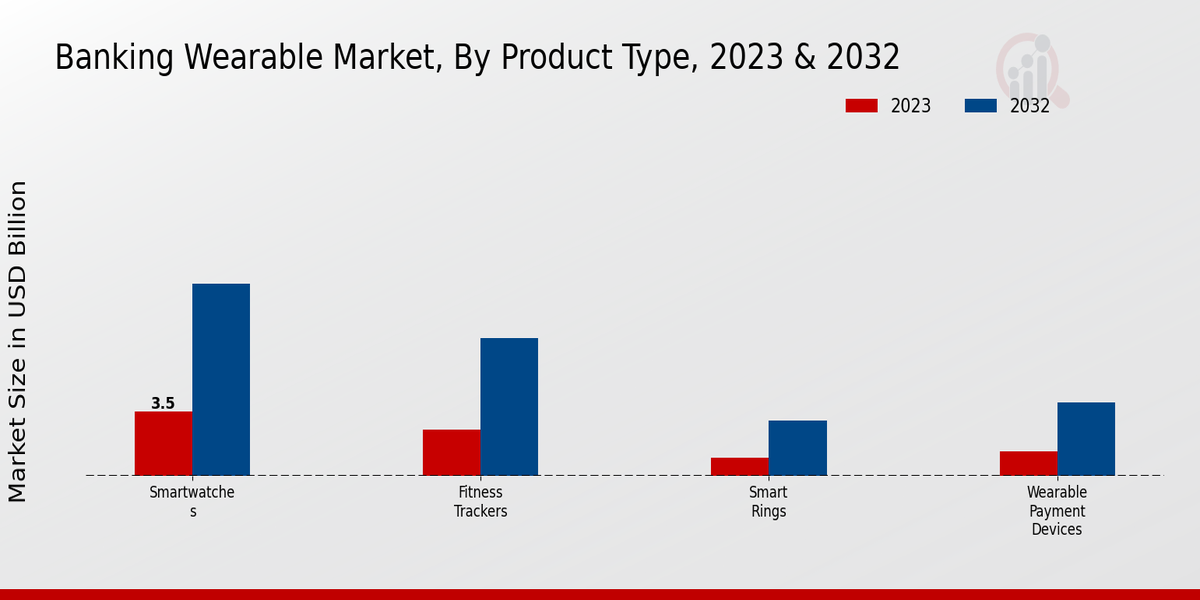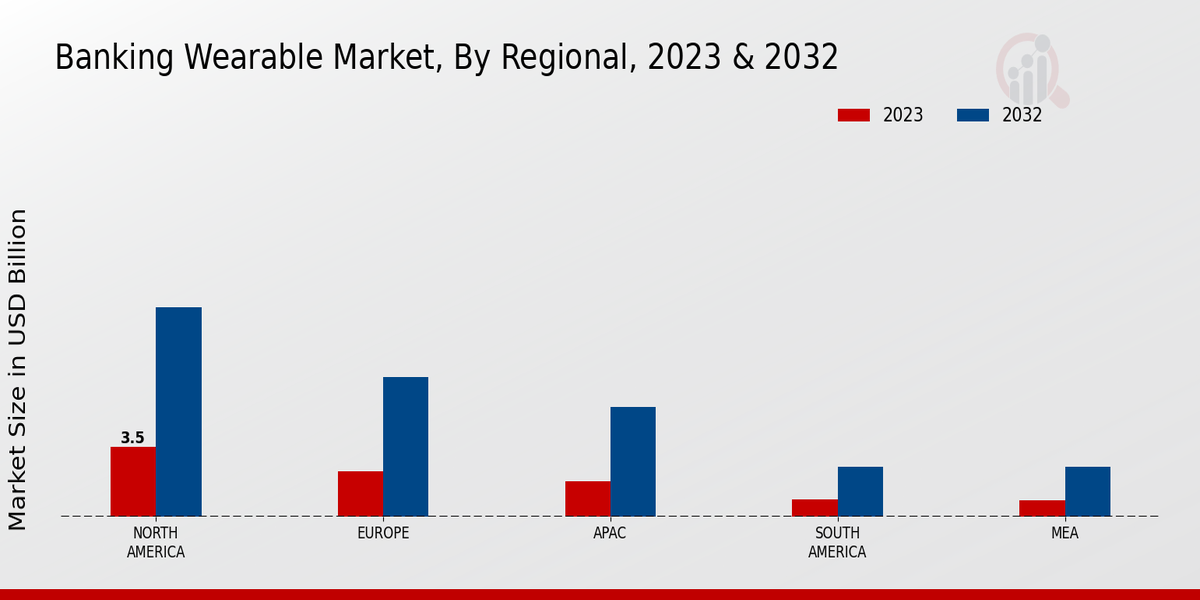Global Banking Wearable Market Overview:
Banking Wearable Market Size was estimated at 10.62 (USD Billion) in 2024. The Banking Wearable Market Industry is expected to grow from 12.53 (USD Billion) in 2025 to 36.99 (USD Billion) till 2034, exhibiting a compound annual growth rate (CAGR) of 13.12% during the forecast period (2025 - 2034).
Key Banking Wearable Market Trends Highlighted
The Banking Wearable Market is being significantly influenced by several key market drivers. The increasing emphasis on convenience and seamless banking experiences is prompting financial institutions to explore innovative wearable technology solutions.
As consumers become more accustomed to using wearables for various purposes, the initial challenge of integrating banking functionalities into these devices is rapidly transforming into a trend toward enhanced user experience.
Security concerns also play a pivotal role in driving this market, as robust authentication methods and improved cybersecurity measures are being prioritized to build trust among users.
Opportunities in this space are ripe for exploration, particularly in the realm of personalized financial services. Financial institutions can leverage advancements in wearable technology to offer tailored services, such as real-time spending alerts and budget management tools, directly on users' wrists.
Collaborations between tech companies and banks are also likely to create new business models that capitalize on data analytics. This can lead to improved customer engagement, as wearables can provide instant access to banking services, making transactions more efficient and user-friendly.
Recent trends indicate a growing focus on health and fitness wearables that feature banking capabilities, highlighting the convergence of finance and wellness. Moreover, the integration of artificial intelligence and machine learning into wearable banking technologies is fostering more sophisticated applications, enabling predictive analytics for users' spending habits.
As the market evolves, adopting a holistic view integrating health, security, and personalized services will be crucial for stakeholders aiming to capture growth opportunities and stay ahead in this competitive landscape.

Source: Primary Research, Secondary Research, MRFR Database and Analyst Review
Banking Wearable Market Drivers
Technological Advancements in Wearable Devices
The Banking Wearable Market is experiencing rapid growth due to significant technological advancements in wearable devices.
The emergence of sophisticated technologies such as Near Field Communication (NFC), biometric sensors, and artificial intelligence have enabled the development of next-generation wearable products. These innovations allow users to conduct banking transactions seamlessly and securely, fostering consumer adoption and enhancing user experience.
Moreover, the integration of wearable devices with mobile banking applications has boosted the functionality and convenience of these products, enabling users to perform tasks such as checking account balances, making payments, and transferring funds with ease.
Enhanced connectivity, improved battery life, and increased processing power in wearable technology encourage consumers to adopt banking wearables as an essential financial management tool.
The ongoing evolution in design and user interfaces has led to more aesthetically appealing and user-friendly devices, further promoting market penetration. As wearable technology becomes more prevalent and embedded in everyday activities, the Banking Wearable Market is poised for sustained expansion.
Growing Consumer Preference for Contactless Payments
A notable driver of growth in the Banking Wearable Market is the growing consumer preference for contactless payment methods. The demand for quick and secure payment solutions has intensified, particularly in a post-pandemic world where physical distancing has become the norm.
Wearable devices equipped with contactless payment features provide convenience and enhance security, making them an attractive option for consumers. This shift toward cashless transactions is not only promoting the use of banking wearables but also driving financial institutions to innovate and adapt their services accordingly.
Increasing Financial Inclusion Initiatives
The Banking Wearable Market is also witnessing growth driven by increasing financial inclusion initiatives globally. Many countries and organizations are promoting access to banking services for unbanked or underbanked populations.
Wearable devices can serve as effective tools to reach these underserved communities, providing access to essential financial services that were previously unavailable. This demographic expansion represents a significant opportunity for market growth as wearables become a lifeline for individuals seeking to manage their finances efficiently.
Banking Wearable Market Segment Insights:
Banking Wearable Market Product Type Insights
This growth is driven by a surge in consumer interest in wearable technology, particularly in the context of banking and financial transactions. The market is segmented by product type, which significantly influences overall revenue generation and trends observed in the industry. Among these product types, Smartwatches are emerging as a dominant force within the segment.
Valued at around 3.5 USD Billion in 2023, Smartwatches are expected to increase to 10.5 USD Billion by 2032. The integration of banking applications and contactless payment systems has made Smartwatches an attractive option for consumers who seek convenience and functionality in their wearable devices.
In addition to Smartwatches, Fitness Trackers are another important segment within the Banking Wearable Market. This segment was valued at 2.5 USD Billion in 2023 and is anticipated to grow to 7.5 USD Billion by 2032.
The increasing focus on health and wellness, combined with advancements in technology, has led fitness enthusiasts to opt for these devices, which often include features that allow for seamless payment options during workouts or outdoor activities. Smart Rings, while a smaller segment of the market, are gaining traction with a market value of 1.0 USD Billion in 2023, projected to reach 3.0 USD Billion by 2032.
Their compact design and discreet nature make Smart Rings an appealing option for consumers who may prefer minimalistic wearables yet desire access to banking functionalities. Lastly, Wearable Payment Devices, valued at 1.32 USD Billion in 2023 and expected to grow to 4.0 USD Billion by 2032, are specifically designed for financial transactions and represent a critical part of the industry.
These devices capitalize on trends toward cashless societies and the demand for quick, versatile payment solutions through wearable formats. The Banking Wearable Market segmentation reflects the varied preferences of consumers and highlights potential growth areas as technologies evolve.
Market growth is further supported by trends such as increased digitization, the proliferation of online banking, and the rising adoption of contactless payment solutions across numerous sectors. However, challenges such as data security and consumer trust still persist, presenting both risks and opportunities for stakeholders in the market.
As the Banking Wearable Market continues to expand, staying abreast of market data and statistics will be crucial for participants aiming to leverage the growing interest in wearable technology within the financial landscape.

Source: Primary Research, Secondary Research, MRFR Database and Analyst Review
Banking Wearable Market Technology Insights
This growth is largely fueled by advancements in technologies like Near Field Communication (NFC), Bluetooth, QR Code Scanning, and Health Monitoring Sensors, which enhance user experiences and security in banking transactions.
NFC technology is crucial for contactless payments, enabling seamless transactions through devices such as smartwatches and wearable payment devices. Bluetooth technology facilitates easy connectivity among various wearable gadgets, broadening their usability in banking.
QR Code Scanning, gaining traction due to its convenience, allows users to perform transactions by scanning codes directly with their devices.
Meanwhile, Health Monitoring Sensors are emerging as vital tools in banking wearables, as they provide valuable health data that can be integrated with financial services, promoting a holistic approach to personal finance management.
Collectively, these technologies represent a pivotal aspect of the Banking Wearable Market revenue dynamics, presenting ample opportunities and challenges for industry players navigating this evolving landscape.
Banking Wearable Market User Demographics Insights
The growth is driven by the increasing adoption of wearable technology among various user demographics, particularly Young Adults (18-25), Working Professionals (26-45), Older Adults (46+), and Tech-Savvy Consumers.
In 2023, Young Adults are projected to drive the market significantly, capitalizing on the popularity of smartwatches and fitness trackers for their tech-savvy lifestyle, which falls within the current valuation of 3.5 USD Billion for smartwatches and 2.5 USD Billion for fitness trackers.
Working Professionals are increasingly incorporating wearable payment devices into their daily routines, accessing financial services on-the-go, with the wearable payment device segment valued at 1.32 USD Billion in 2023.
Older Adults are gradually embracing these technologies, primarily for health monitoring and financial security, providing further opportunities for market expansion.
The Banking Wearable Market segmentation illustrates how each demographic responds to technological advancements, underscoring the trends driving market growth and the challenges surrounding user adoption, such as privacy concerns and varying tech-savviness across age groups.
As the market evolves, the intersection of these demographics will also present new opportunities for innovative product offerings tailored to their unique needs, enhancing user experience and engagement.
Banking Wearable Market Functionality Insights
Within the Functionality segment, key sub-segments such as Payment Processing, Health Monitoring, Transaction Alerts, and Lifestyle Tracking play a pivotal role in this evolution.
Notably, Payment Processing is expected to lead the market, showing strong demand for secure transaction capabilities via wearables. Health Monitoring is gaining traction as consumer awareness around personal health management increases, thus driving innovations in wearable technology.
Meanwhile, Transaction Alerts facilitate real-time updates, enhancing user experience and providing users with timely information for better financial management.
Additionally, Lifestyle Tracking continues to see growth as users integrate wearables into their daily routines for managing health and wellness, allowing for a seamless connection between banking services and personal goals.
Collectively, these Functionalities contribute significantly to the Banking Wearable Market revenue, reflecting changing consumer behaviors and the ongoing digital transformation in the banking industry. The market data indicates momentum for smartwatches valued at 10.5 USD Billion and fitness trackers at 7.5 USD Billion by 2032, further underscoring the potential within these segments.
Banking Wearable Market Adoption Rate Insights
The Adoption Rate segment of the Banking Wearable Market reveals a significant trajectory, aligning with the market's forecasted valuation of 25.0 USD billion by 2032, from 8.32 USD billion in 2023, reflecting a robust compound annual growth rate (CAGR) of 13.01 from 2024 to 2032.
The sub-segment of Smartwatches demonstrates a prominent presence, anticipated to surge from 3.5 USD billion in 2023 to 10.5 USD billion in 2032, indicating substantial adoption among Early Adopters and Mainstream Users driven by features such as contactless payments and health monitoring.
Fitness Trackers also contribute to this expansion, with a valuation projected to elevate from 2.5 USD billion in 2023 to 7.5 USD billion by 2032, appealing primarily to health-conscious Mainstream Users.
Meanwhile, Smart Rings and Wearable Payment Devices, valued at 1.0 USD billion and 1.32 USD billion in 2023, respectively, are expected to attract interest from Late Majority users as the technology matures and awareness increases, thus fostering a steady growth in the Banking Wearable Market segmentation.
Overall, the Banking Wearable Market revenue will be influenced by emerging trends such as advanced functionalities, growing consumer awareness, and the rising demand for convenience, enhancing the market growth within this adoption landscape.
Banking Wearable Market Regional Insights
The Regional segment of the Banking Wearable Market is poised for significant growth, driven by increasing adoption and technological advancements across various regions.

Source: Primary Research, Secondary Research, MRFR Database and Analyst Review
Banking Wearable Market Key Players and Competitive Insights:
The Banking Wearable Market is an evolving sector that showcases a notable intersection between finance and technology. With the growing integration of smart devices in everyday banking, consumers are increasingly seeking convenience and efficiency in managing their finances. The wearables in this market segment are not just about fitness tracking but have expanded functionalities that allow users to conduct transactions, receive alerts, and monitor financial data on the go.
This shift in consumer habits, coupled with advancements in technology, has resulted in a competitive landscape where innovation, brand reputation, and user experience reign supreme. Providers of banking wearables are required to navigate the complexities of regulatory compliance, privacy concerns, and the need for robust cybersecurity measures in a market characterized by rapid technological change.
Seiko has established a notable presence in the Banking Wearable Market through its reputation for precision and quality craftsmanship. The brand leverages its heritage in watchmaking to provide reliable and sophisticated wearable solutions tailored to the financial sector.
With a focus on innovation, Seiko integrates advanced technology into its wearables, emphasizing functionalities such as secure digital payment systems, personalized financial monitoring tools, and seamless user interfaces that enhance the banking experience.
The brand's commitment to combining stylish design with cutting-edge technology has garnered customer loyalty, empowering users to engage with their banking needs in a modern and efficient manner. Seiko's ability to blend traditional watchmaking expertise with contemporary digital demands positions it uniquely within this competitive market.
Sony, a prominent player in the Banking Wearable Market, is recognized for its innovative approach to technology and consumer electronics. The brand's foray into banking wearables focuses on integrating multimedia capabilities with financial functionalities, thus offering consumers a unique, multifaceted experience.
Sony emphasizes usability and design, ensuring that its devices not only serve banking purposes but also provide features such as multimedia functions, notifications, and compatibility with various financial applications.
This integration broadens the appeal of Sony wearables to a tech-savvy audience looking for both style and practicality. Additionally, the brand's investment in R&D enables it to stay ahead of market trends, consistently innovating to meet the evolving needs of consumers in the banking sphere.
Sony's strategic focus on enhancing user engagement through its banking wearables underscores its competitiveness in this dynamic market.
Key Companies in the banking wearable market Include:
-
Seiko
-
Sony
-
Fossil Group
-
Fitbit
-
Amazfit
-
Nokia
-
Casio
-
Samsung
-
Xiaomi
-
Withings
-
Huawei
-
Misfit
-
Paladone
-
Apple
-
Garmin
Banking Wearable Industry Developments
Recent developments in the Banking Wearable Market indicate a robust growth trajectory driven by technological advancements and changing consumer preferences. The integration of biometric authentication features in wearable devices is gaining traction, enhancing security in banking transactions.
Financial institutions are increasingly collaborating with tech companies to develop innovative solutions, such as smartwatches and fitness bands with built-in payment functionalities. Regulatory bodies are also adapting to these changes, ensuring that guidelines keep pace with rapid technological developments.
Moreover, the rising adoption of IoT and artificial intelligence in connected devices is expected to offer enhanced customer experiences and facilitate seamless transactions. Major players are focusing on expanding their product portfolios, with an emphasis on user-friendly interfaces and secure payment systems.
As consumers become more reliant on wearable technology for financial management, investment in research and development within the sector continues to grow. The emerging trend of personalized financial services delivered through wearables reflects a significant shift towards consumer-centric banking solutions, signaling a promising future for the market.
Banking Wearable Market Segmentation Insights
-
Banking Wearable Market Product Type Outlook
-
Smartwatches
-
Fitness Trackers
-
Smart Rings
-
Wearable Payment Devices
-
Banking Wearable Market Technology Outlook
-
Banking Wearable Market User Demographics Outlook
-
Banking Wearable Market Functionality Outlook
-
Payment Processing
-
Health Monitoring
-
Transaction Alerts
-
Lifestyle Tracking
-
Banking Wearable Market Adoption Rate Outlook
-
Early Adopters
-
Mainstream Users
-
Late Majority
-
Banking Wearable Market Regional Outlook
-
North America
-
Europe
-
South America
-
Asia Pacific
-
Middle East and Africa
|
Report Attribute/Metric
|
Details
|
|
Market Size 2024
|
USD 10.62 Billion
|
|
Market Size 2025
|
USD 12.53 Billion
|
|
Market Size 2034
|
USD 36.99 Billion
|
|
Compound Annual Growth Rate (CAGR)
|
13.12% (2025-2034)
|
|
Base Year
|
2024
|
|
Market Forecast Period
|
2025-2034
|
|
Historical Data
|
2020-2023
|
| Market Forecast Units |
USD Billion |
| Key Companies Profiled |
Seiko, Sony, Fossil Group, Fitbit, Amazfit, Nokia, Casio, Samsung, Xiaomi, Withings, Huawei, Misfit, Paladone, Apple, Garmin |
| Segments Covered |
Product Type, Technology, User Demographics, Functionality, Adoption Rate, Regional |
| Key Market Opportunities |
Increased mobile payment adoption Integration with personal finance apps Enhanced security features demand Growth of IoT banking solutions Rise in health tracking capabilities |
| Key Market Dynamics |
Rising demand for mobile banking Increasing adoption of wearables Enhanced security features Integration with IoT devices Growing focus on user experience |
| Countries Covered |
North America, Europe, APAC, South America, MEA |
Frequently Asked Questions (FAQ) :
The Banking Wearable Market is expected to be valued at 36.99 USD Billion in 2034.
The projected CAGR for the Banking Wearable Market from 2025 to 2034 is 13.12%.
The Smartwatches segment is expected to be the largest, valued at 10.5 USD Billion in 2032.
North America holds the largest market share, valued at 10.5 USD Billion in 2032.
The Fitness Trackers segment is expected to be valued at 7.5 USD Billion in 2032.
The Wearable Payment Devices segment is expected to reach 4.0 USD Billion in 2032.
The Banking Wearable Market was valued at 8.32 USD Billion in 2023.
The APAC region is expected to be valued at 5.5 USD Billion in 2032.
Major competitors include Seiko, Sony, Fossil Group, Fitbit, Amazfit, Nokia, and Apple.
The Smart Rings segment is projected to be valued at 3.0 USD Billion in 2032.

















